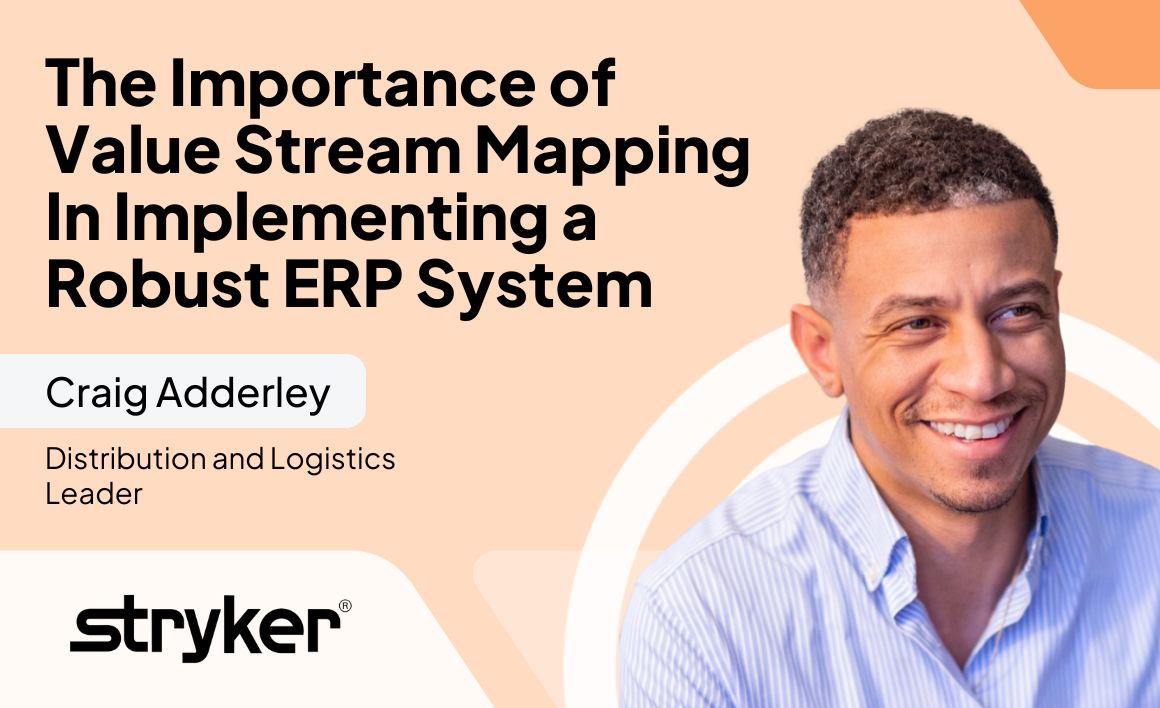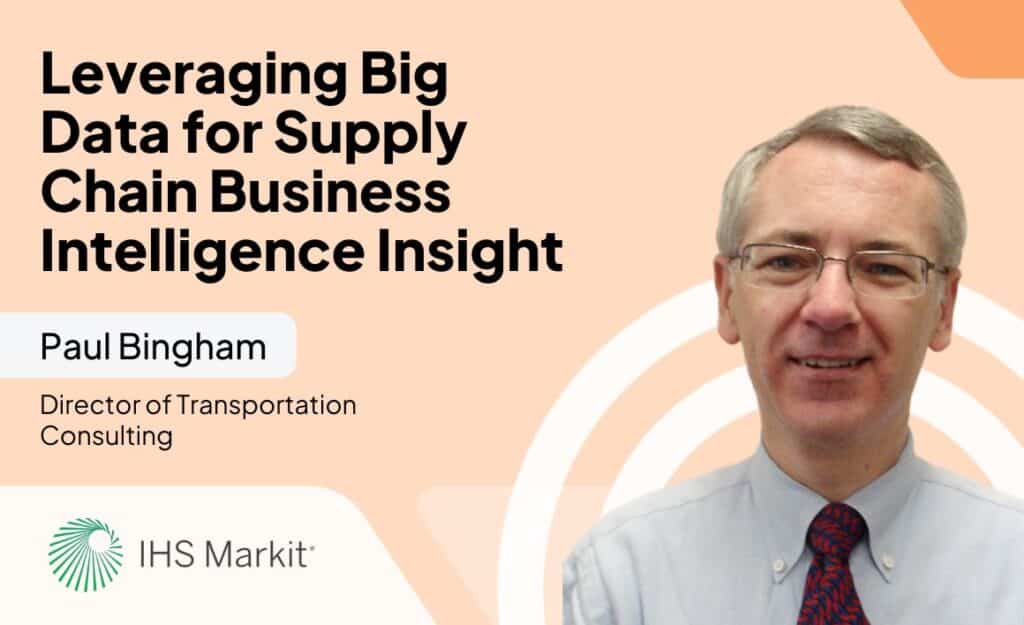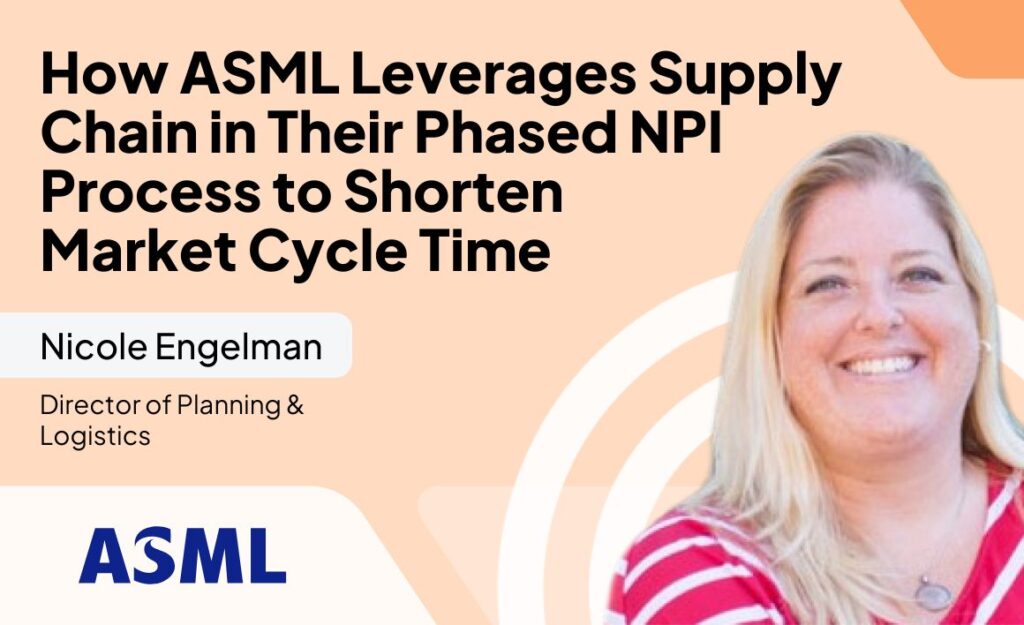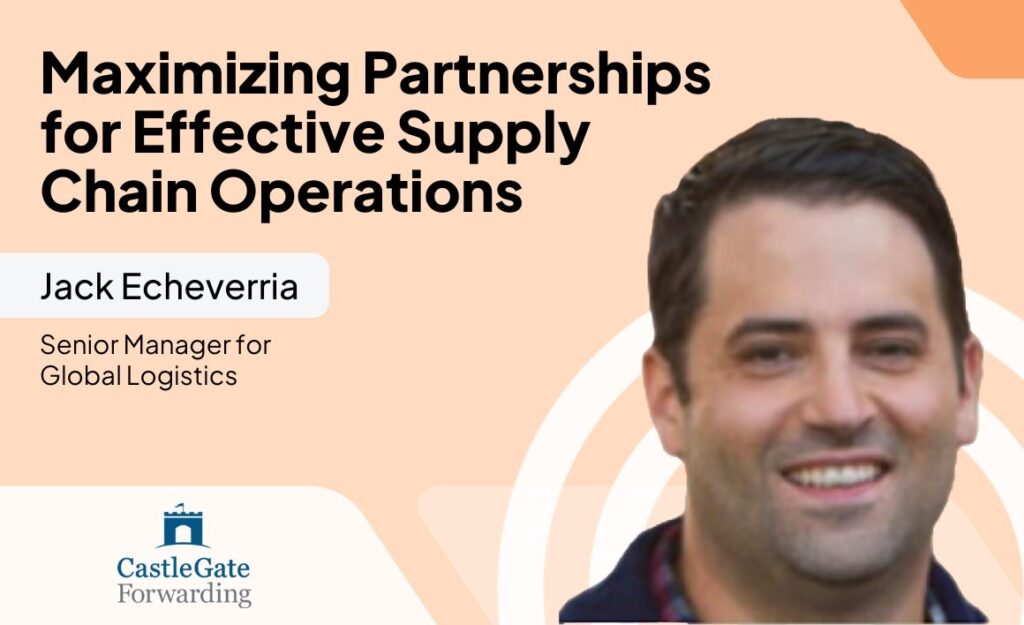
The Importance of Value Stream Mapping In Implementing a Robust ERP System with Stryker’s Craig Adderley
Craig Adderley
19:38
“If you have a robust ERP system and you have everything documented, you have this value stream map where you know where you need to focus on relieving your bottlenecks because that’s what’s adding or is taking away the most value. You have more clarity, and you have more perspective. With more perspective comes more clarity. With clarity, it just becomes a better way of decision-making because you see the whole picture.”
– Craig Adderley, Distribution and Logistics Leader at Stryker Endoscopy
Full transcript
Francis Adanza:
Welcome to the Down to Freight podcast, where we sit down with transportation, logistics, supply chain, subject matter experts to discuss digital transformation projects. I’m the host of the show, Francis Adanza, and it’s a pleasure to welcome Craig Adderley, Global Transportation and Logistics leader. Craig, thank you for joining today’s episode.
Craig Adderley:
Yes. Thanks for having me, Francis. Really excited to be here. And like you mentioned, been in transportation for a while now, recently in a transition mode. A lot of people are, but my role is the Global Transportation and Logistics leader at Air Liquide Advanced Materials. And now I’m in a transition to a new organization in the medical field, really excited about that.
Francis Adanza:
Awesome. We’re glad to have you. So can you tell folks a little bit more about yourself, your previous company, the company that you’re working for and any of the challenges that you wrestled with in your career?
Craig Adderley:
Yes. So coming from Air Liquide Advanced Materials, a lot of people may not be familiar with, but we operate in the semiconductor industry and manufacturing space. Really an industry leader in development and manufacturing and the delivery of specialty gases and liquids and even solid materials across the globe. So our primary focus was really high technology industry and just a part of like an elite club of delivering that next-generation computer technology, the kind that you see in your phone, your TVs and in the future, smart cars and self-driving vehicles.
And on the molecular level, when we look deep inside, what I was really responsible for is making sure that we get the right product at the right place at the right time so that we could create and add value to this ever evolving market for faster, better microchips. So think artificial intelligence, new devices, the Internet of Things, that was mainly our core competency.
Francis Adanza:
Oh wow, I did not know that, but that’s really interesting. So you talked about some of the parts and components of the end products that we consumers use. Could you provide a little bit of overview on the supply chain and how things work to get all of those little pieces together?
Craig Adderley:
Yes, absolutely. When you think about it, we have a lot of individual parts. And in most supply chains, you’re used to hands-on materials that you can move and place places. What we’re dealing with are gases and liquids, and that’s a lot harder to manage. It’s a lot harder to take from one state to a new state, especially because it’s mostly containing different types of hazards that are not really meant for human consumption.
So when we look at our supply chain, and this is kind of where we’re at today when we talk about transitioning to our ERP system, as we look at how do we take these gases and liquids that need to be in a certain condition and a certain type of packaging and a certain temperature and how do we take those across different environments outside, inside residential, nonresidential and how do we still get it to the customer safely across the ocean by air. And it really comes down to are our systems integrated enough and robust enough to handle the small transactions and the large bulk transactions all at the same time and make sense of it so that our customer gets the right information.
Francis Adanza:
It sounds like there’s a lot of responsibility and liabilities that go along with the transportation of that material. So you mentioned ERP. So I take it that’s the digital project that we’re going to be covering today.
Craig Adderley:
Yes. ERP, we’re transitioning. We’ve been using a lot of what you would call the tribal knowledge method of really getting things from A to B, and it’s worked out great. We’re transforming from a mom-and-pop type of 2 companies merging together, where Air Liquide comes in with bringing in the best practices from being industrial gas. And we’re taking these specialty companies, and we’re trying to use those best practices. And one of them is implementing a robust ERP system that helps us put all the pieces together and communicate effectively.
Francis Adanza:
And so was that the primary challenge that you were trying to solve was information being trapped in silos? What led to this switch?
Craig Adderley:
Yes. Well, we started looking at our inefficiencies and started realizing that these small inefficiencies were beginning to add up. We needed better integrations for our suppliers and customers so that we can get the timely information where it needs to go. And that was a huge efficiency that we saw that we were able to create.
In addition to cost and time we spent on the system maintenance and configuration, there was a lot of manual adjustments when the regulations and the industry itself is changing rapidly, and we needed some sort of system that was easily agile and nimble to be able to adapt to the changes in our industry. Those were 2 primary drivers. Just all these small inefficiencies that we finally measured and found out that they’re not adding value to the end customer result, how can we close that gap and then how do we get information streamlined in a way that’s immediate so that we could spend less time wasted on trying to solve problems that don’t need to exist.
Francis Adanza:
I see. That makes a lot of sense. You talked about some of this tribal knowledge. Can you share a little bit about how you got started? Any particular challenges that you faced along the way? And overall, how long did it take to complete this implementation?
Craig Adderley:
Yes. Some of the major challenges of the tribal knowledge is that — are people related, okay? So you have individuals that are legacy people, as you call them. They’re just dedicated to the company. They’ve done a great job and know what they’re doing but have a hard time passing that information down or across their cohort and their peers. And so we realized that a lot of these activities were activities that could be a system action that didn’t need that manual involvement.
So how do we do that? We have to take those activities and condense them and say, hey, which of these activities can we transform into a one-click activity or 2-click activity? And so first, we started with that. And that was a challenge because it was just a mentality shift. And so we had to go through this phase. And there are multiple leaders from engineering to R&D on to procurement that we’re all were trying to speak the same language. And so we had a 5-phase plan, and I’ll be honest, we’re not done. I unfortunately transitioned right at the Phase 4, which we’ll get in a little bit. But one of the main ways that we started that was we had a big kick off.
And what we had to do was explain where we’re heading, why now and what will be different once we are complete, once we’ve implemented our process. And those were really in-depth conversations that involved surveys, where we took 1 to 4 questions, kept it simple and kind of asked our entire organization, hey, do you strongly agree or disagree with these activities where we’re heading and is the timing right? And we used those to decide how we’re going to launch. So that was Phase 1.
And then Phase 2, I wouldn’t say it’s the most important thing, but it’s a highly important phase is the value stream mapping. And it’s really looking — we spent time between January through those months in the beginning of the year taking our key subject matter experts. We didn’t want everybody involved in a value stream mapping sessions. But we took our subject matter experts and we said, now let’s walk from beginning to end, from raw material to finished goods, how this process works. And let’s talk about what are the key drivers of success and how do we either automate, optimize or improve those processes and then input those into our ERP system so that they are a nimble but robust way of making sure that we stick to a process, right?
So we need a process that’s standardized, but we need a system that allows us with that standardization to pivot when demand or industry calls us to. So we focused on a value stream mapping that mapped out where we’re at, where we want to be and what things are valued that we need to keep an input into our new ERP system. And mind you, we’re not building the ERP system, right? We are giving the inputs. A lot of people don’t realize when you’re implementing an ERP system, there’s third-party consultants that have to come in and really help us engineer and build it on the back end. And we’re just here spending hours with these experts kind of fleshing out what we do and how we want to make it improve for the future.
Francis Adanza:
That’s awesome. I think the approach sounds — while I haven’t done it myself personally, but I think the approach sounds spot on. So you broke it down into these different phases. And then I think sometimes people get too caught up in the to-dos, but you’ve taken a step back. And looking at that value stream mapping, while I’ve never heard of that before, it seems like a critical step to your point to make sure that this project is successful so that you’re focusing on the key objectives that actually pertain to the outcomes that you’re trying to achieve and not get lost in some of the daily action items.
Craig Adderley:
Yes. And it really comes down to change management. You have to get the buy-in from each subject matter expert, each user. So we really spend a lot of time or actually, I should say, some of the sponsors for the project spent a lot of time. I was focused more on the logistics and transportation end of things, but the real heroes of this big project were the people that were spending the time in the multiple subject matter expert areas, right, visiting facilities in the first phase of the rollout, observing these processes, documenting them, figuring out that there’s opportunities for improvement.
And with that, we have lots of challenges. Additionally, when you think about it, disrupting a person’s day-to-day operations, like you’re coming in, you’re saying, hey, instead of a 90% pace, I want you to work at a 70% pace because I need you to explain each step so that I can capture it. But what you’re doing is you’re sacrificing time today for an improvement tomorrow, right? And a lot of people miss that. And that’s where the frustration lies in the organization. They’re like, well, we’ve got to spend so many hours talking about this and that. Well, yes, today.
But next year or 6 months from now or 2 months from now, what you’ll have is a — well, what’s the word I’m looking for? You have a very — I just keep saying robust, but it’s the best way to drive it. You have an agile, robust system that knows exactly what needs to be done. And now you’re reducing the activities from 50% of your day to 25% of your day simply because you spent 25% of your day 6 months ago fleshing it all out. So if planting a seed, you got to let it grow.
Francis Adanza:
It sounds like you had a well-thought out plan and you were very methodical with the value stream mapping but very rarely do things go according to plan. Were there any hiccups or anything unforeseen that you could learn from or share that others might be able to take away and hopefully make new mistakes?
Craig Adderley:
That’s a great question. One of the things we did discover and, personally, I saw it with my team is how our success really depends on diverse stakeholder involvement. You need participation in all the learning and contribution opportunities. And the hardest thing to coordinate is those day-to-day whirlwinds. So what people don’t expect is they don’t expect meetings to be interrupted by a truck having an incident at the dock or they don’t expect the day to be interrupted by somebody being sick or going on leave, FMLA.
So it’s all these unforeseen events, the daily whirlwind, I like to call it, that people don’t take into account and then are surprised when the timeline gets pushed. One thing I will say is with the ERP rollout, the timeline will never stay the same. It’s just only in a perfect world, well, when you say, oh, we’re going to be launching in Q2 of 2022. I can say almost without a shadow of a doubt, that’s going to push at least 2 quarters to maybe a whole year later.
It’s inevitable because what they don’t factor in is the human life, the weather, COVID. You just don’t know what’s coming around the corner, breakdown, system integration problems, IT infrastructure problems, like there’s so much that can happen during an ERP launch implementation. And you have to be prepared for it, and you have to be very flexible with your time lines. I’d say that.
Francis Adanza:
That’s the truth. So I know that you mentioned that you were in the middle of it before you transitioned out. But was the organization starting to realize any of the anticipated benefits? And if so, how are you measuring the before and after?
Craig Adderley:
Great question. In the facilities that are operational, we know where the inventory is, where it moves and the rate of which it moves. So that’s a good start. That’s the starting point. If I want to look at our anticipated benefits, I would say we’ve become way more agile. We’ll be able to identify where things are at risk of breaking down much quicker. And it’s because we can see the entire system clearly in one click. Right now, we have to rely on people glue, human glue to get us the answers of inventory, of moves, of transfers, of customer orders, of where at with this freight.
But if you have a robust ERP system and you have everything documented, you have this value stream map where you know where you need to focus on relieving your bottlenecks because that’s what’s adding or is taking away the most value. What you have is a system that — you have more clarity. And with perspective — well, I should say, you have more perspective. And with more perspective comes more clarity, right? And with clarity just comes a better way of decision-making because you see the whole picture.
So I anticipate that as the launch continues, even in my absence, and as we look at the leaders there that are just superb at asking the right questions, even with this big turnover that we see all the time throughout all the industries, I think it’s going to improve our onboarding. We’ll be able to retain knowledge for people that we lose because now we’ve captured it in a systematic way that’s replicable and it’s in a centralized place instead of in people’s heads. So I anticipate the knowledge transfer. I anticipate our ability to be more agile and nimble and just our operations be more visibility to our inventory, knowing where it moves, how it moves.
And then we could say, hey, so we noticed that our inventory turnover rate is X, Y and Z. And now that we could see it clearly, let’s find out the impetus that’s causing that to occur so we can approach problems more holistically.
Francis Adanza:
Got it. Now that you’ve started your new role, what’s on the horizon for you in the medical device supply chain and logistics?
Craig Adderley:
Great question. I’m excited about this industry because it’s the opposite of what I said before. It’s tangible stuff. It’s things I can see and touch, right? It’s the tools in surgery rooms. It’s the equipment that they’re using in operation rooms. We are literally helping keep people alive on a day-to-day basis. So that’s motivational to me. That’s one thing.
And the second thing is the fast pace of this industry. The medical industry is a staple to our society, right? We need good medicine and good doctors to help us grow as a population and keep innovating. And in order to do that, they have to have the right tools and resources. And we are here at the forefront in the medical industry providing things for sports med, for surgery and for endoscopy and a lot of the major neurovascular procedures that are happening. So I love it.
I think for me right now, I’m taking a lot of these global transportation learnings and I’m applying it more on the distribution warehousing side. And I’m looking at our warehouses and I’m saying to myself, okay, where are inefficiencies? Where can we find the weak links in our supply chain and reinforce them, not just replace everything? But how do we reinforce what’s already there and if we need to replace them? What are some of the ways that we consolidate strengths and expertise and utilize it to make a more optimal operation?
And ironically enough, there’s a plan to launch ERP for this company in 2022. So that’s funny. It’s like hopping from one ERP to the next, and it’s pretty exciting.
Francis Adanza:
Well, hopefully, you’ll be able to unlearn from your own experiences and this one will be a lot smoother.
Craig Adderley:
Absolutely.
Francis Adanza:
Well, thanks, Craig. This was super informative. I’m sure the listeners are going to appreciate these lessons learned from a massive ERP replacement. I can see this being applicable to teams that are upgrading their existing systems as well as those that are planning to rip and replace new ones. So thank you very much for your time today and for chatting with me.
Craig Adderley:
Yes, definitely, Francis. Thanks for having me. And I love what you’re doing with the podcast. And I hope it adds value to many of the experts out there trying to fight this wave of logistics, transportation failures that we’re seeing across the industry. So I’m excited to be a part of it. Thank you.
Francis Adanza:
Absolutely. Thank you.
Craig Adderley:
Yes.
Continue listening
Ready to transform your supply chain?
Increase efficiency and productivity. Say goodbye to delays, handwriting errors, and time-intensive manual data entry.




